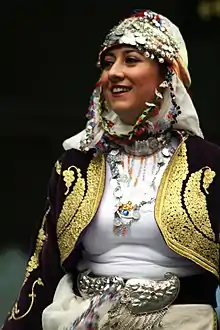Turkish folk dress
Turkish folk dress is a traditional style of clothing worn primarily in the rural parts of Turkey. Within the folk style of clothing are many variations based on region, gender, ethnicity, and class of the wearer.

Influences
Traditional Turkish clothing is heavily influenced by Ottoman Empire fashion. The borders of the Ottoman Empire encompassed the numerous individual cultures that existed in Central Asia, the Middle East, and Anatolia. Ottoman culture, and particularly Ottoman fashion, evolved as an amalgam of these separate cultures and religions that interacted over the centuries. Ottoman fashion did not disappear with the fall of the Ottoman Empire, however; it lived on and continued to evolve in the several nations that emerged from it, including Turkey. Some notable features of Ottoman fashion were the mintan, heavily embroidered jacket, salver, baggy pants, the sarik, a wrapped headpiece, and the entari, a long flowy jacket.[1]
Turkish folk styles
Folk clothing in Turkey embodies the crossing over and interaction of the various cultures in and around Anatolia. On top of that, the fashion of each region in Turkey tends to reflect the nature of its people. For instance, Eastern Anatolian fashion reflects elements of the neighboring Kurdish and Armenian cultures, like overall simple clothing with floral prints for women and wide belts for men. And the traditional fashion of the Black Sea region is bold and proud-spirited, seen in its deep colors and vivid patterns. Features that are present in most of Turkey include stripes, baggy clothing, multiple layers, and bright colors.[2]
State control of dress
The Kemalist regime, which assumed power in 1923, implemented strict policies of modernization and secularization in all aspects of Turkish society, including clothing styles. In 1925, the state announced a ban on the fez, a classic symbol of the Ottoman era. On top of that, in 1934, the state banned the Islamic veil for women, an element of Islamic tradition.[3] Atatürk decided that both pieces were too old-fashioned, the veil too religious, and did not reflect Western fashion trends. These bans were thoroughly respected in the cities of Turkey, but they had less of an impact in the Turkish countryside, where traditional Turkish styles, particularly in men's dress – while incorporating some Western features, like the trouser and the cap, as a result of Atatürk's modernization – remain alive and diverse.
References
- "TURKISH CLOTHING." History of Turkish Clothing. N.p., n.d. Web. 21 Feb. 2017.
- Sofiya. "Home." Each of seven Turkey regions has its own clothing traditions and features - Nationalclothing.org. N.p., n.d. Web. 21 Feb. 2017.
- "Turkey covers up." The Economist. The Economist Newspaper, 26 Jan. 2017. Web. 21 Feb. 2017.